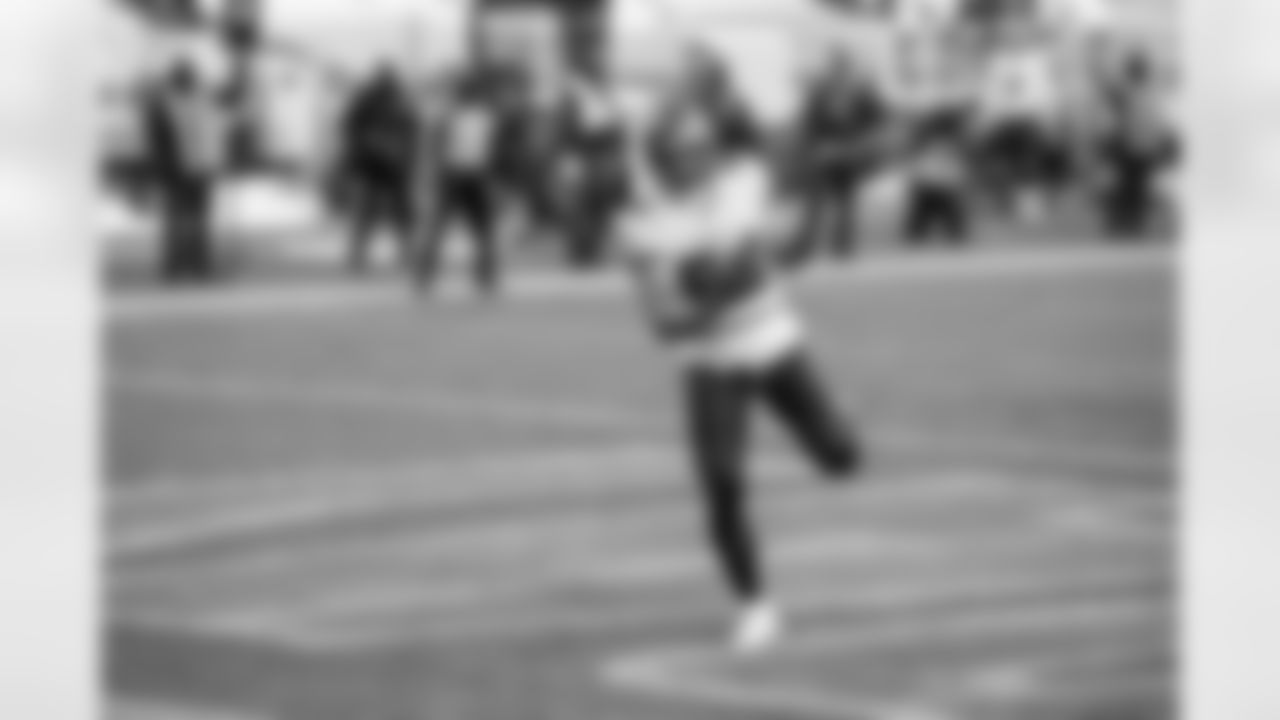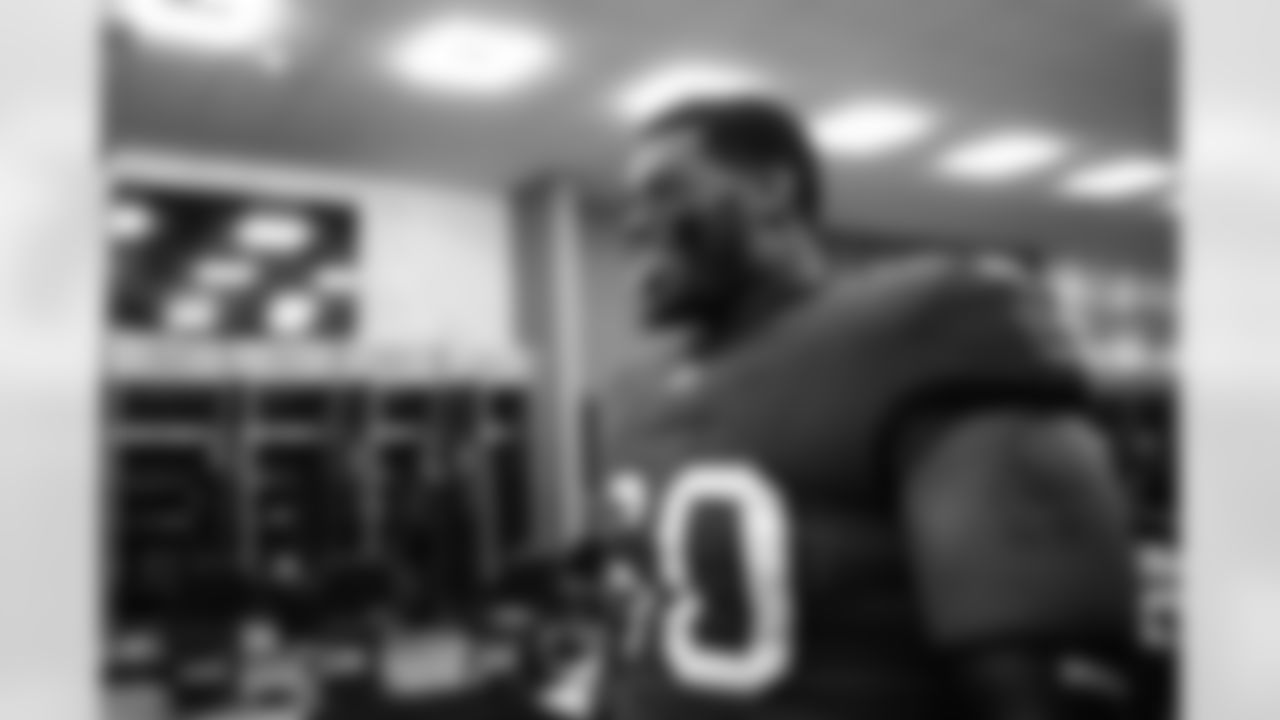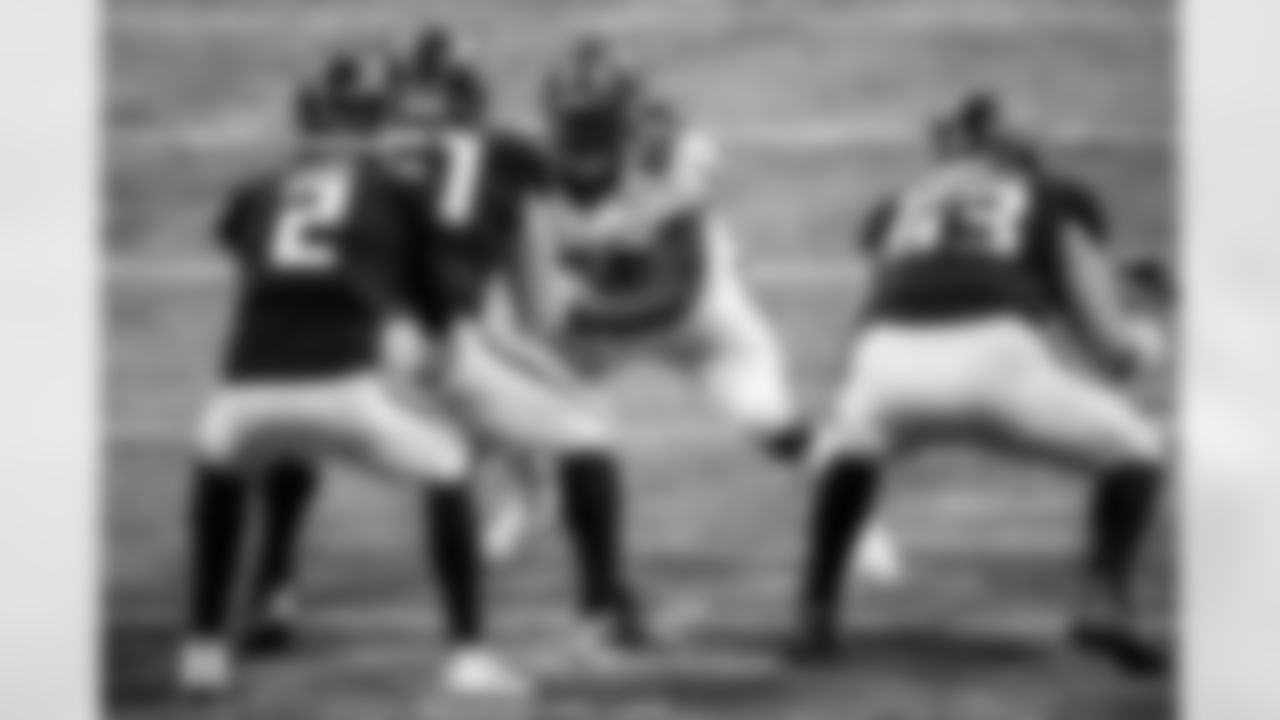The last three times the Tampa Bay Buccaneers have faced off against their upcoming Week Four opponent they were known as the San Diego Chargers and they were piloted by quarterback Philip Rivers, even though those three contests spanned a dozen years. That's largely because Rivers started an incredible 224 games for the Chargers from 2006 through last year.
Those Chargers have since moved out of San Diego to relocate in Los Angeles (and in the new SoFi Stadium this year) and Rivers then made a second move to Indianapolis. It was the Chargers' decision to move on, and they did so in the expected way by using a first-round pick on what they hope will be their next decade-long starter. That was Oregon's Justin Herbert, the sixth-overall selection last April.
Like many teams that make this most dramatic move of drafting a new franchise quarterback, the Chargers intended to introduce Herbert into the lineup gradually while using an experienced veteran as the bridge, in this case Tyrod Taylor. And as actually happens quite frequently in these situations, the rookie finds himself on the field sooner rather than later. In Herbert's case, that began with a pregame surprise in Week Two when Taylor had to be taken to the hospital after a medical mishap left him with a collapsed lung.
Herbert's debut came against the defending-champion Kansas City Chiefs, and all he did was become the first NFL quarterback in NFL history to run and throw for a touchdown in the first half of his debut. The rookie passer threw for 311 yards and helped Los Angeles take the Chiefs all the way to overtime before falling, 23-20. With Taylor still unavailable last weekend, Herbert got another start and threw for another 330 yards in a five-point loss to Carolina.
The Chargers have not yet made it clear if Herbert will make a third straight start or if Taylor will return to the lineup, but the rookie's fast start would seem to give him a shot at holding onto the job for a while. He has the good fortune of being surrounded by a number of very good offensive weapons, though wide receiver Mike Williams is a question mark for Sunday after suffering a hamstring injury in the loss to Carolina.
Chief among those weapons is running back Austin Ekeler, who emerged as one of the NFL's best pass-catching backs last year. More on him below. Keenan Allen is coming off three straight 1,000-yard receiving seasons and has been the focal point of the passing attack so far in 2020, with 37 targets, 23 catches and 265 yards. Allen is tied with Arizona's DeAndre Hopkins for the most targets through three weeks. Tight end Hunter Henry, whose production in his first three seasons has only been limited by his health, already has 16 catches for 206 yards. The only tight end in the NFL with more receiving yards at this point is Kansas City's Travis Kelce.
Los Angeles can move the ball, clearly. What has been tougher is getting it into the end zone. Despite ranking sixth in the league with 425.7 yards per game, the Chargers are 29th in scoring, with 17.3 points per game.
The Chargers' defense is currently operating without three starters, as safety Derwin James, defensive end Melvin Ingram and cornerback Chris Harris are all currently on injured reserve. All three are former Pro Bowlers and Harris was one of the Chargers' most important offseason acquisition. Even without those three, Los Angeles has stars or stars-in-the-making at every level of their defense, beginning up front with Joey Bosa, one of the NFL's best pass-rusher. The Bolts doubled up on first-round picks in April, trading up to get Oklahoma linebacker Kenneth Murray, and he's their leading tackler. Casey Hayward has been among the NFL's best cornerbacks since leaving Green Bay for San Diego (and then L.A.) in 2016. Here's a closer look at some of the challenges and opportunities the Bucs will encounter in Denver when the take their second road trip of the 2020 season:
CHARGERS DIFFERENCE-MAKERS
The Chargers used a fourth-round pick to pair UCLA's Joshua Kelly with Ekeler in the backfield and the Chargers are averaging 151.7 rushing yards per game and 4.3 yards per carry. The defense may have lost 2020 addition Harris for four to six weeks but another one of their newcomers, 330-pound defensive tackle Linval Joseph, remains a run-stopping force in the middle. Here are four more Denver players who could make things difficult for the Buccaneers on Sunday;
1. DE Joey Bosa. Bosa was the first defensive player drafted in 2016 and he has lived up to that billing, with 43.0 sacks in his first 54 NFL games. That includes 3.0 so far this year, with exactly one in each of the Chargers' first three games. In addition to his 11.5 sacks last year, Bosa had 31 quarterback hits and 18 tackles for loss. At 6-5 and 280 pounds, Bosa has the size to play a power game but he dips and bends around the corner like a smaller man. He has a full toolbox of pass-rush moves and will use one play to set up a blocker for something different on the next snap. Like all elite pass-rushers, Bosa has an explosive first step but he can convert that into power and bull-rush an opponent. He is also an all-around defender on the edge, playing well against the run and even making tackles in space. He most often rushes from the left side of the Chargers' defensive front but will occasionally flip to the other side.
2. RB Austin Ekeler. Given a chance to become the main man in the backfield last season with Melvin Gordon's brief holdout, Ekeler emerged as one of the NFL's most productive running backs. His receiving line from 2019 would make most receivers proud: 93 catches for 993 yards and eight touchdowns. This year, he is tied for second among all running backs in receptions with 16 and is second in receiving yards, with 142, both behind the Saints' Alvin Kamara. Though Ekeler has lined up in the slot and split out wide on a handful of snaps this year, most of his production has come with him lining up in the backfield before going out on a route. He's sure-handed, too; so far 100% of the passes thrown his way have been caught this season. Ekeler (5-10, 200) is also a better runner between the tackles than he is largely given credit for and is averaging 5.0 yards per carry so far in 2020. The Buccaneers have mostly done a good job of containing a trio of good pass-catching backs so far in Christian McCaffrey, Alvin Kamara and Melvin Gordon, but Ekeler is going to give that group another stiff test Sunday.
3. CB Casey Hayward. After four seasons and just 20 starts in Green Bay, Hayward has blossomed since signing with the Chargers. He made the Pro Bowl in each of his first two seasons with his new team and had 13 interceptions over the last four seasons combined. Hayward's passes-defensed totals dropped from a combined 42 in 2016-17 to 16 in 2018-19, but he already has a team-leading three break-ups in 2020. Once thought to be primarily a slot corner, Hayward has developed into a very good outside corner for the Chargers. He sees most of his time on the left side of the defense but could possibly be used as a matchup player with Mike Evans on Sunday, particularly if Chris Godwin is unavailable. The Chargers only have one interception so far in 2020, and none from defensive backs, and in general are looking for more splash plays out of the defense. Like Bosa in front of him, Hayward is one of the team's best candidates to start making those splashes.
4. T Bryan Bulaga. Bulaga is another former Packer, though he arrived four years after Hayward. The Chargers signed him to a lucrative three-year deal in the offseason in the hopes of settling down at least one of the tackle positions that has been in flux in recent years, in part due to injuries. The 6-5, 314-pound Bulaga spent nine years as one of the NFL's most dependable right tackles in Green Bay, at least when he was on the field. The only blemish on his career has been a string of injuries that allowed him to play only two 16-game seasons for the Packers. Bulaga as strong at the point of attack, can handle bull-rushes and hand-fighting and is quick enough to limit speed rushers off the edge. As noted above, the Chargers have one of the NFL's best rushing attacks in 2020 and they also rank 15th in sacks allowed per pass play. The L.A. line is dealing with some injuries, including Bulaga's back, but so far the new addition up front has been a big part of an effective line.
View photos of the Tampa Bay Buccaneers 53-man roster.

S Andrew Adams

OLB Shaquil Barrett

RB Le'Veon Bell

RB Giovani Bernard

QB Tom Brady

TE Cameron Brate

OLB K.J. Britt

G Alex Cappa

CB Ross Cockrell

WR Jaelon Darden

ILB Lavonte David

CB Carlton Davis III

CB Jamel Dean

CB Dee Delaney

CB Pierre Desir

S Mike Edwards

WR Mike Evans

RB Leonard Fournette

QB Blaine Gabbert

DL William Gholston

OLB Cam Gill

WR Cyril Grayson Jr.

TE Rob Gronkowski

OL Robert Hainsey

TE O.J. Howard

C Ryan Jensen

WR Tyler Johnson

RB Ronald Jones II

G Nick Leverett

G Ali Marpet

DT Steve McLendon

WR Scotty Miller

ILB Kevin Minter

CB Sean Murphy-Bunting

OLB Anthony Nelson

DT Rakeem Nunez-Roches

WR Breshad Perriman

OLB Jason Pierre-Paul

P Bradley Pinion

CB Rashard Robinson

OT Donovan Smith

G Aaron Stinnie

ILB Grant Stuard

K Ryan Succop

DL Ndamukong Suh

QB Kyle Trask

LS Zach Triner

OLB Joe Tryon-Shoyinka

RB Ke'Shawn Vaughn

DT Vita Vea

WR Justin Watson

OT Josh Wells

ILB Devin White

S Jordan Whitehead

S Antoine Winfield Jr.

T Tristan Wirfs
STRENGTHS
The top-level rankings suggest that the Chargers are a strong and balanced team. Los Angeles ranks sixth in offensive yards and is in the top eight both rushing and passing the ball. The defense ranks ninth, meanwhile, and is also balanced, with top-11 rankings against but the run and the pass. The offense has converted exactly half of its third-down tries and the defense is holding opposing teams to the third-lowest average of first downs per game. Here are some more specific areas in which the Chargers have done well early in the 2020 season:
• The Chargers' defense has been nothing short of phenomenal in the red zone. Opponents have penetrated their red zone nine times and have come away with just two touchdowns and six field goals. That 22.2% red zone TD rate allowed is easily the best in the league and far better than the league average of 62.1%. Three of those red zone drives have turned into goal-to-go opportunities for the opposition but none of those resulted in touchdowns. The Chargers are the only team that has yet to allow a first-and-goal to turn into a TD.
• Chargers kicker Michael Badgley made 87.5% of his field goal tries (28 of 32) and 97.9% of his extra point attempts (46 of 47) through his first two seasons in the NFL, both of which ranked eighth among all qualifying NFL kickers in that span. Badgley is off to a good start again in 2020, having made six of his seven field goal tries and all four of his PATs. His only miss was a 50-yarder in the season opener but he has also made all three tries between 40 and 49 yards.
• San Diego's defense has mostly defended the deep ball well, as evidenced on a basic level by its 10.1 yards allowed per catch, sixth-lowest in the NFL. The Chargers' average of 6.0 yards at the point of the catch is also eighth-lowest in the league. Specifically, Los Angeles has defended the deep ball perfectly down the middle and down the left side. Opponents have tried six passes in those two areas combined and completed none of them. The Chargers have been more vulnerable to the deep right, allowing four completions on nine such passes.
• One of the reasons that the Chargers have converted an impressive 50% of their third down tries on offense, as noted above, is that they have done a good job of staying out of long third downs. Of their 44 third-down plays, 63.6% of them have come with the team needing six or fewer yards to convert the first down. That's the seventh-best mark in that category in the NFL.
WEAKNESSES
The Los Angeles defense has given up 4.6 yards per carry so far and it hasn't yet generated much pass rush apart from Joey Bosa. As noted above, the Chargers' offense hasn't converted its high yardage total into a corresponding number of points. In addition:
• As good as the Los Angeles defense has been at winning in goal-to-go situations, the Chargers' offense has been among the league's least successful in that situation. Los Angeles has only converted four of their eight first-and-goal situations into touchdowns through the first three games. That 50% success rate is the fifth-lowest average in the league.
• The Chargers' kick coverage units haven't had too many chances against opposing return men yet, but they haven't fared particularly well on the ones they've had to stop. L.A.'s opponents have averaged 13.3 yards on four punt returns and 36.7 yards on three kickoff returns, with a long return of 44.
• The Chargers have a talented secondary, though it was hurt before the season began when Derwin James landed on injured reserve. L.A. ranks ninth in pass defense overall but has not yet begun to take the ball away from opposing offenses. In fact, the Chargers only have one interception on defense so far, and that was recorded by Melvin Ingram, a defensive end who is now on injured reserve. The Bolts' interception rate of 0.90% is fifth-worst in the NFL.
• If he's going to continue to start, Herbert could use some help from his targets on getting separation, or perhaps in which players he targets and when. So far, Chargers' pass-catchers have had an average of 3.02 yards per separation from the closest defender at the time of the catch. That's just the 23rd-best average in the NFL.
NEW FACES IN 2020
As noted above, the Chargers used the sixth-overall pick in the 2020 draft to add their long-term replacement for Philip Rivers. But Los Angeles also traded back up into the first round to get a key piece for the middle of the defense. Fourth-round running back Joshua Kelley has also jumped right into the mix with Austin Ekeler in the rushing attack, and Bulaga isn't the only new starter on the Chargers' offensive line.
1. G Trai Turner. The Chargers and Panthers pulled off one of the more intriguing trades of the offseason when L.A.'s left tackle, Russell Okung, was shipped to Carolina for Pro Bowl right guard Trai Turner. Obviously, the Chargers filled the resulting hole at left tackle by signing Bulaga to play right tackle and moving Sam Tevi from that side to the left. The result is a right side of the line that could rank among the NFL's best.
2. DT Linval Joseph. The Vikings released Joseph in March after six seasons, and the Chargers quickly stepped in to give the 11th-year veteran a new two-year deal. The 330-pound Joseph might not be quite as disruptive in the middle as he was in his prime but he is still difficult to move and an important part of the Chargers' 11th-ranked rush defense.
3. LB Kenneth Murray. That key defensive piece the Chargers traded up for in April was Oklahoma's Murray, a very active and rangy linebacker who stepped right in on the weak side. Murray has already established himself as the team's leading tackler, with 23 stops through three games, and he also has a tackle for a loss and a pass defensed.
ABSENCES/POTENTIAL ABSENCES
1. Trai Turner/Bryan Bulaga/Tyree St. Louis/Mike Pouncey. We called Bulaga a Difference-Maker above and noted his addition along with that of Turner in the New Faces section. However, both Bulaga and Turner show up here as well because both are dealing with injuries that could keep them out of Sunday's game in Tampa. Turner missed last week's game due to a groin injury and Bulaga left that contest early with a back ailment. Tyree St. Louis started in Turner's place last Sunday but left after three plays due to light-headedness and was replaced by Ryan Groy. Trey Pipkins stepped in at tackle when Bulaga went down. Los Angeles is also without Pro Bowl center for the rest of the season due to a hip ailment.
2. QB Tyrod Taylor/WR Mike Williams. In the immediate aftermath of Taylor's sideline mishap and Herbert's first start, Head Coach Anthony Lynn said that Taylor would remain the Chargers' starter and that the veteran gave his team the best chance to win. However, Herbert has thrown for over 300 yards in each of his two starts and has a 90.2 passer rating so far. Lynn may not have to decide this week if Taylor is unavailable for a third straight game. Whichever Chargers quarterback is throwing the ball, he may not have the option to look in Williams' direction. The veteran receiver left last week's game early with a hamstring injury.
3. CB Chris Harris. Harris, the former Broncos standout, was one of the Chargers' key offseason acquisitions, and the four-time Pro Bowler has been an active part of their defense, playing 92.4% of the team's defensive snaps. Harris has 15 tackles and a pass defensed through his first three games. However, he won't be adding to those stats for at least a month as he has been sidelined by a foot injury sustained in the game against the Chargers.



































